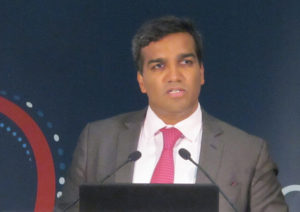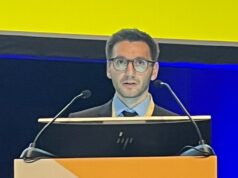Pulsed-field ablation (PFA) and/or radiofrequency ablation (RFA) using a lattice-tip catheter can both isolate pulmonary veins (PVs) and create linear lesions efficiently and safely, with a high degree of lesion durability, and promising freedom from arrythmia recurrence. This was the main takeaway message of the presentation titled “Clinical outcomes of lattice tip focal ablation for AF: toggling between pulsed field and radiofrequency energy” presented by Vivek Reddy (Homolka Hospital, Prague, Czech Republic and Ichan School of Medicine at Mount Sinai, New York, USA) at the 27th Annual Atrial Fibrillation Symposium (January 13–15, 2022 New York, USA).

Commencing the presentation, Reddy described the catheter dimensions of a 9mm lattice tip and a 7.5Fr catheter shaft, highlighting the catheter’s ability to deliver either PFA or RFA. Alluding to the differences in ablation techniques on the surface thermocouples, he explained “with RF you see an elevation in temperature, whereas with PF, minimal to no temperature elevation and both of these lesions are about 3-5 seconds long”.
Referring to the presentation last year at the 26th annual AF symposium meeting which covered “acute procedural performance” in 76 patients and published in Circulation: Arrhythmia, Reddy highlighted the progress made since then, having treated 178 patients. Among this patient population, the average age was 59.7± 9.4 years, enrolling more males (n=128) males than females (n=50). He adds, there were more persistent atrial fibrillation (perAF) patients (n=108) than paroxysmal atrial fibrillation (PAF) (n=70).
This non-randomised first-in-human trial, enrolled patients (n=178) across three European centres, with 11 operators including the Homolka Hospital and IKEM, Prague, Czech Republic, and Vilnius University, Vilnius, Lithuania. Reddy described the procedures, all carried out under general anaesthesia, usually using a detectable sheath, using intra-cardiac ultrasound (ICE) in all patients. Using an esophageal “management” strategy of “leaving it alone”, usually no esophageal temperature probe was used, and when used, this was for monitoring only, with no esophageal deviation or cooling. Pulmonary vein isolation (PVI) was performed in all patients, and linear lesions were as desired, according to operator preference of either cavotricuspid isthmus (CTI), mitral and/or left atrial roof (LA roof).
Making reference to PVI procedures, Reddy described PFA delivered by biphasic waveform (1.3–2.0 kV) with three different pulse waveforms. Pulse–1 was two–five seconds per lesion in patients, and pulse–2 and –3 was four seconds per lesion in 47 and 51 patients, respectively. RFA was temperature-controlled (maximum 73 degrees) and saline-irrigated, with five seconds per lesion. He also noted that during linear lesions, energy was either delivered by PFA or RFA, with patients allocated to either of the subsequent two cohort groups, RF/PF or PF/PF. In the PVI procedure, the RF/PF cohort received RF anteriorly, and PF posteriorly (n=79), with the PF/PF cohort receiving PF throughout (n=99). The proposed plan of the study was a re-map procedure at approximately three months post-index ablation.
Reddy reported the number of patients to be 178 (100%) for PVI, 78 (44%) for the mitral line, 130 (73%) for the LA roof line, 38 (21%) for box lesion, and 121 (68%) for CTI line, with 100% acute success in all lines.
Relaying the results, Reddy stated the transpired ablation time for both RF/PF and PF/PF were similar, at 21 and 22 minutes respectively. The three waveforms’ ablation times, again, were around 20 minutes at 23 minutes for pulse–1, 21 minutes for pulse–2, and 20 minutes for pulse–3. He reported the ablation time for the linear lesions to be quick, at four minutes for the mitral line, with the LA roof line and CTI line taking less than two minutes.
First-pass PVI was high across all three waveforms, at 83% in pulse–1 and 98% in both pulse–2 and pulse–3, with fluoro time averaging at 4.3 minutes (range 0–14.1 minutes). Remapping was carried out in 122 (69%) patients, at an average of 96 ± 43 days after the index procedure.
Reddy explained that the durability of PVI varied between pulse waveforms, with the highest durability in pulse–3 at 97% (n=124) per PV, equating to the isolation of all veins in 90% (n=31) of patients. The PVI durability was lower in pulse–2 at 87% (n=178), equating to 64% (n=44) of patients with all veins isolated, with the lowest durability in pulse–1 at 51% (n=191) per PV, equating to only 32% (n=47) of patients with all veins isolated. Reddy also noted that the durability of pulse–3 was similar in RF/PF and PF/PF cohorts. The LA roof line were performed with PF, with 100% durability with pulse–3 (n=30), 67% durability in the mitral line, and 86% durability in the CTI line.
Drawing attention to the pulse–3 cohort (n=54) only, he relayed that freedom from AF was “quite high”, with only 15 patients at risk for perAF at a year post-procedure, however, Reddy notes that these patients were all perAF, as there were very few PAF patients at the pulse–3 waveform. In the RF/PF cohort group, there were no major adverse events, except for one hospitalisation, who was a patient with inflammatory pericardial effusion, treated for perAF.
Sharing his final thoughts, Reddy concludes that “PF/PF and RF/PF with the lattice-tip catheter can both isolate PVs and create linear lesions efficiently and safely with a high degree of lesion durability, and promising freedom from arrythmia recurrence”. Reddy described the main study limitations as a small number of operators and centres. Looking to the future, Reddy details that the SPHERE perAF FDA IDE trial, a randomised control comparing lattice-tip RF/PF and conventional RFA has commenced, with the first patient enrolled in December 2021.
Following the conclusion of his presentation, the panel asked “Where do you see the use of PF and RF?”
In response, Reddy answered “If you are close to the AV node and the sinus node, I think it is going to be a little while before I will feel comfortable delivering PF because I feel less comfortable about the transient local effect. We do not know how PF affects the ganglia, so we do not know if we are trading some success for another. What I mean by that is, for example it is possible that we are getting better durability, but we are not hitting the ganglia with pure PF. Maybe the improved success of improved durability is offset by the decreased success of not hitting the ganglia, so maybe the overall success rates look similar”.
Reddy notes his disclosure of Affera Inc: Consultant, with Equity









